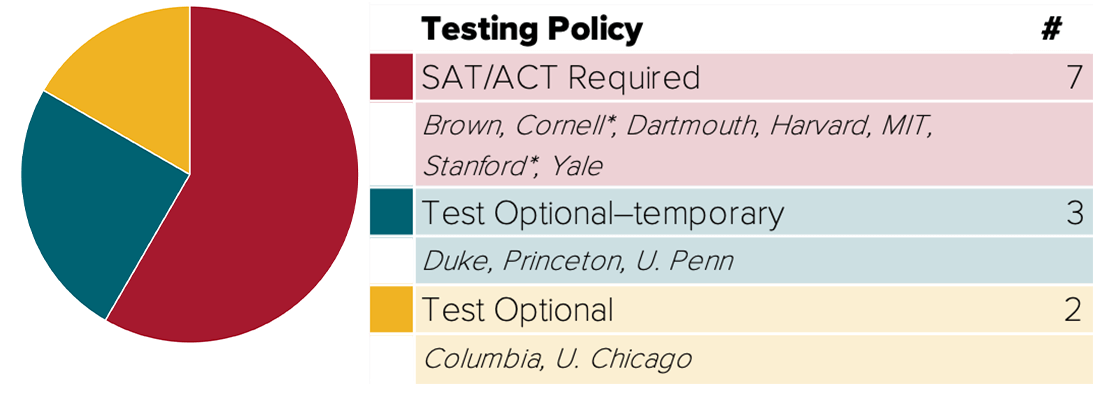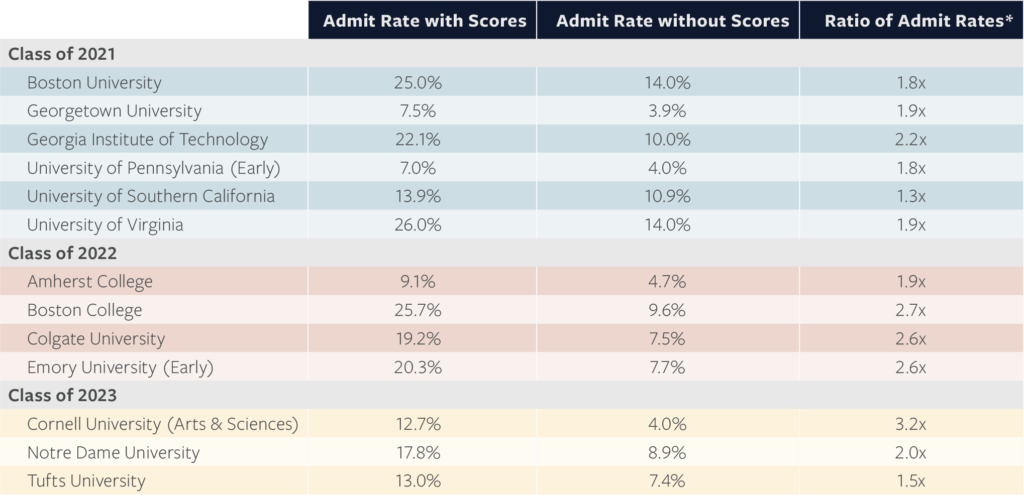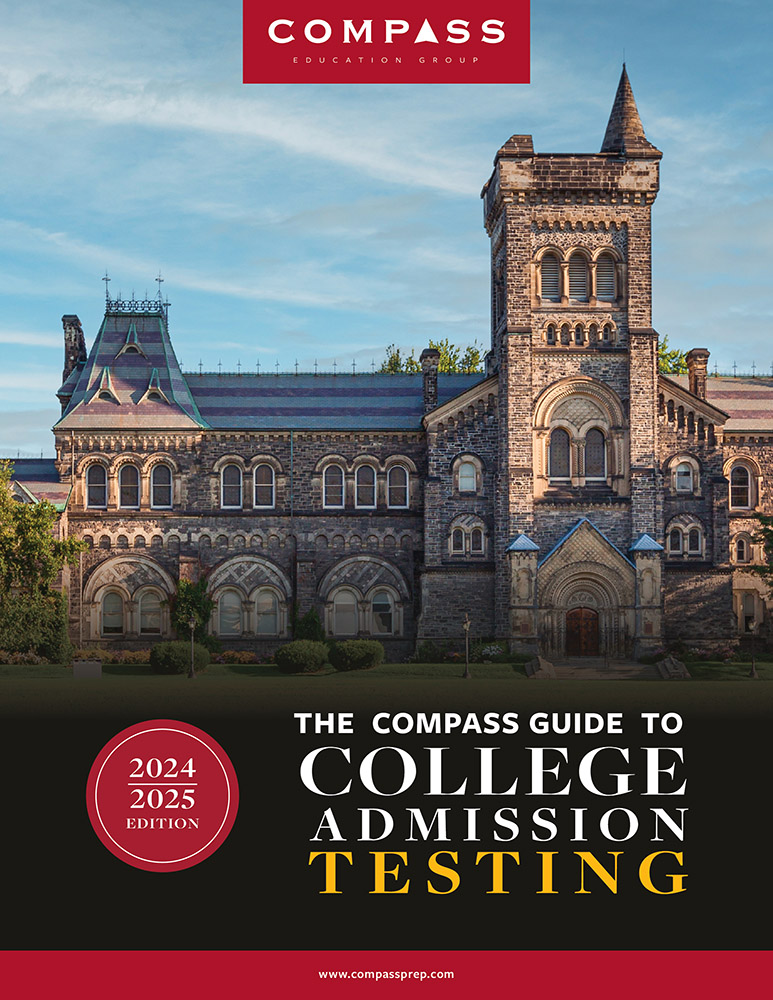
This year several prominent schools made headlines for reinstating testing requirements. Brown, Caltech, Cornell, Dartmouth, Harvard, Stanford, and Yale joined Georgetown and MIT on a list of popular private institutions that are ending their temporary test optional allowances. College applicants will also face testing requirements at the service academies and at several public institutions including University of Texas—Austin, Purdue, and the University Systems of Georgia, Florida, and Tennessee.
The consensus is that this trend will continue, especially at highly competitive colleges, although it’s also believed that hundreds of other colleges will remain test optional indefinitely.
The chart below consolidates well-known colleges into major policy categories. In actuality, inside the groupings of test optional institutions, applicants may encounter colleges that state a preference, a recommendation, or even an expectation of test scores in the absence of special circumstances. It is important for prospective applicants to listen closely to the signals coming from a college’s guidance and admission trends.
Current testing policy breakdown for the 400+ schools Compass tracks:

Current testing policy breakdown for the 12 “Ivy Plus” Schools:
 * Effective fall 2026.
* Effective fall 2026.
OPTING TO TEST
More and more students have been choosing to obtain scores. The classes of 2022 and 2023 had substantial increases in SAT takers (up 13% and 12%, respectively) from the prior year, as participation continues to climb back up to pre-pandemic levels. Applicants with scores benefit from the flexibility to decide how test results should or should not factor into their final submissions. 2024 also saw the debut of the new and shorter digital SAT, which seemed to lift test-taking interest even higher.
CLASSES OF 2025 & 2026: TESTING IS BACK—WHAT TO WATCH
An indirect consequence of policy reversals at one set of schools is a rising number of selective test optional colleges receiving scores from their strongest applicants. Students planning to apply to highly popular colleges should consider what others with similar opportunities are apt to voluntarily submit as a competitive edge. Scores remain a valuable piece of the holistic review process at many schools, especially those where demand for admission drastically outstrips supply.
Expiring test optional policies should be tracked closely. And, as Harvard and Caltech demonstrated, colleges can reverse course even before temporary policies expire. While Cornell is honoring its existing test optional policy for the class of 2025, it is also being honest with applicants that scores are recommended in the interim (except at their test free schools). Yale is an example of a school that added flexibility to its reinstated requirement, but it remains to be seen how useful AP and IB options (in lieu of SAT/ACT) will be there and elsewhere.
Meanwhile, most college counselors and college admissions insiders are keenly monitoring the remaining “Ivy Plus” schools and several others that influence policy and test-taking behavior.
TEST OPTIONAL OUTCOMES
The data in the table below are a sampling of recent admissions statistics at colleges with competitive admissions. While inexhaustive, this group offers a glimpse into the additive role test scores and submission decisions played in more sought-after contexts.
The figures imply a higher likelihood of admission for applicants with test scores than for those without, in some cases more than twice as high. Nonetheless, students who are disadvantaged or discouraged by testing will have ample possibilities, as the option to withhold scores will remain common for the class of 2025 and beyond.
While the presence of scores may correlate to higher admission rates at some schools, this apparent “admissions advantage” for score submitters is often misunderstood, misinterpreted, and over-simplified, partly due to colleges being less than fully transparent. Colleges are not intentionally misleading but can be intentionally opaque. For example, internal admission practices may drift before external policy language gets updated. Additionally, few colleges are willing to disclose these figures anymore.
Despite this sampling of decision data, it can’t be said that sending scores will automatically lead to better outcomes. High scores are also associated with better GPAs and other measures of success. Score submission, though, remains a means for students to distinguish themselves from other applicants. As yet, no research has undercut that position.

* A 2.0x admit rate ratio, for example, indicates that test submitters were admitted at twice the rate of non-submitters.
Colleges are hesitant to report admission statistics by test submission status. Above are a sampling of those that have released figures in announcements or reports.
PARSING OUT TEST OPTIONAL POLICIES
The test optional landscape is neither monolithic nor binary. It is a highly fragmented field, with colleges on a spectrum regarding what is or isn’t preferred or recommended. It is risky to interpret or present test policies in generalized terms; in truth, there are layers of nuance across a range of institutional philosophies and complicated relationships with testing. It is best to examine colleges case-by-case to understand what is expected. Moreover, testing’s relevance and evaluation often differ between pools of applicants to the same college in the same year, and yet colleges try to address all applicants with uniform policy language. This is as frustrating for colleges as it is confusing for applicants.
TO SUBMIT OR NOT
Unfortunately, test optional ubiquity has introduced an unintended strategic element to the process. Some students have successfully gamed it, while others have made tactical errors of “mis-withholding” scores that would have helped.
It is an easy miscalculation to make. The new normal of discretionary testing has inflated the averages of reported scores and caused unhelpful distortions to published figures. This statistical deception leads to dubious implications and bad decisions by both applicants and readers. Students might fear a score is now “too low” to disclose, while admissions officers might assume the applicant is concealing a score that is lower than it truly is. That leaves counselors feeling understandably irresolute about advising students.
Will a reader assume nothing about the absence of a score when their college’s own research confirms that withheld scores are typically 100–150 points below their average?
Admissions Research Consortium Study: SAT scores and academic performance at 47 public and private universities

* Percentiles were calculated within an institution’s student population.
Slowly, the prevailing best practice seems to be trending toward sending scores, when in doubt. In fact, this strategy might be most fitting at schools with exceedingly low acceptance rates. At such outliers, readers already know the bulk of applicants will be denied, so they search for reasons to admit. Paradoxically, while even a near-perfect SAT score won’t stand out as reason alone to admit someone, a score slightly below a college’s middle range will typically still be seen as affirming and “high enough” if the rest of the application wholly supports that decision. On the other hand, colleges that are a bit less selective but conspicuously aspirational may be more intent on protecting their averages.
It is therefore impossible to give a rule that applies to all students in all situations. So instead, we encourage you to seek your college counselor’s advice and appraise the wording of specific policies for additional insight into a school’s attitude toward testing. Statements released by a number of popular schools include color about where they stand and what they are experiencing. For instance:
- The decision to suspend our testing requirement was in response to the pandemic; our suspension is—for now—temporary;
- Those who have ACT/SAT scores are welcome/encouraged to submit them;
- Those who have test scores from other standardized exams may submit those;
- Test scores are considered in context. Even if your score is not above average for [the college], but it is for your high school or neighborhood, your score may help you in the admission process.
It can then be helpful to place any given college into one of three frameworks:
- WHERE TESTING IS STILL IMPORTANT
These colleges have admit rates around or below 10%. Almost every applicant is qualified; virtually every applicant is denied. Test optional policies have lowered admission rates further. Applicants must provide a strong case for admission. Students can choose to demonstrate a strength in testing or choose to blend in with other non-submitters. As the data on the previous page show, finding a way to stand out can still provide an advantage. - WHERE TESTING CAN ADD VALUE
Supply and demand imbalances necessitate a difficult and careful selection process, but applications are read supportively. Test scores have traditionally mattered but not more than a sustained track record of academic achievement. Strong test scores can help but are not a significant difference maker. - WHERE TESTING IS A LOWER PRIORITY
This is true at colleges that accept the majority of their applicants and evaluate applications based largely on a yes/no assessment of whether a student has shown the capability to succeed at their institution. Admission decisions don’t hinge on test scores, and it appears that testing will only further diminish in importance at such schools moving forward.
At Compass, we look forward to discussing your specific testing considerations. When you’re ready to reach out, we’re here to guide you on the road ahead.

